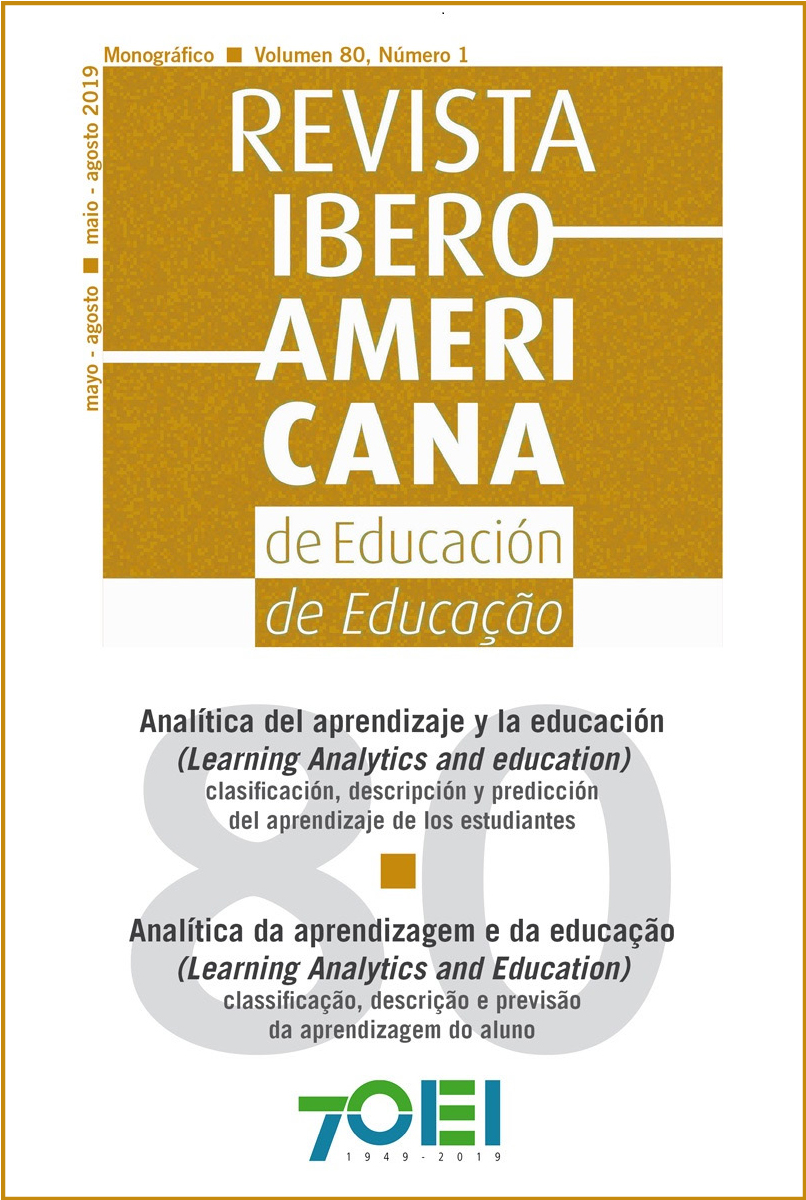Teacher actions in Virtual Learning Environments provided by Learning Analytics tools
DOI:
https://doi.org/10.35362/rie8013459Keywords:
learning analytics, virtual learning environments, distance learning, college education, big data.Abstract
It is noticed that there is a relevant adoption of virtual learning environments (VLE) in higher education, especially in the distance modality. These environments, with the support of Big Data, can provide actions for teaching evaluation practice based on tools that meet the objectives of learning analytics (LA), according to models and life cycles already defined in the literature. The purpose of this study was to consolidate ten possible teaching actions based on these tools, models and life cycles, with the objective of confronting these actions with teachers involved from higher education institutions that work in distance education evidencing them through an experiment where they used six of these tools of teaching profile in their respective disciplines in VLE Moodle. For collection, two semi-structured questionnaires (pre and post-experiment) were used. It was characterized as results of this study that the tools that had the most highlight for LA actions were: Completion Progress (18.5%), Course Dedication (18.1%) and Level Up! (17.8%), followed by "evaluation / feedback" (13.0%) and "intervention" (12.0%) %), thus being compatible with the purpose of reaching the evaluative practice within VLE from these tools.
Downloads
References
Bitencourt, B. M., Severo, M. B., & Gallon, S. (2013). Avaliação da aprendizagem no ensino superior: desafios e potencialidades na educação a distância. Revista Eletrônica de Educação, 7(2), 211-226.
Chatti, M. A., Dyckhoff, A. L., Schroeder, U., & Thüs, H. (2012). A reference model for learning analytics. International Journal of technology enhanced learning (IJTEL) - Special Issue on “State-of-the-art in TEL”, 1-22.
Clow, D. (2012). The learning analytics cycle: closing the loop effectively. Proceedings...LAK ‘12 Proceedings of the 2nd International Conference on Learning Analytics and Knowledge, 134-138.
Daniel, B. (2015). Big Data and analytics in higher education: Opportunities and challenges. British Journal of Educational Technology, 46(5), 904-920.
Dodun, O., Panaite, E., Seghedin, N., Nagît, G., Dusa, P., Nestian, G. Slatineanu (2015). Analysis of an e-learning platform use by means of the axiomatic design. In: 9. International conference on axiomatic design (ICAD 2015). Proceedings...Florence, Italy, v. 34, p. 244-249.
Einhardt, L., Tavares, T.A., & Cechinel, C. (2016, October). Moodle analytics dashboard: a learning analytics tool to visualize users interactions in moodle. In XI Latin American Conference on Learning Objects and Technology (LACLO) (pp. 1-6). IEEE.
Ekuase-Anwansedo, A., Craig, S. F., & Noguera, J. (2018). How to survive a learning management system (LMS) implementation? A stakeholder analysis approach. Proceedings...18th SIGUCCS, p. 165-168.
Gasevic, D., Kovanovic, V., & Joksimovic, S. (2017). Piecing the learning analytics puzzle: a consolidated model of a field of research and practice. Journal Learning: Research and Practice, 3, 63-78.
Khalil, M., & Ebner, M. (2015). Learning analytics: principles and constraints. Proceedings of world conference on educational multimedia, hypermedia and telecommunications, 1326-1336.
Leitner, P., Khalil, M., & Ebner, M. (2017). Learning analytics in higher education: a literature review. In: A. Peña-Ayala (ed.) Learning analytics: fundaments, applications, and trends. Springer international publishing, 1-23.
Machado, L. R., Longhi, M. T., & Behar, P. A. (2013). Domínio tecnológico: saberes e fazeres na educação a distância. In: P. A. Behar, Competências em educação a distância (pp. 56-80). Porto Alegre: Penso.
Iglesias, M.J., Lozano, I., & Roldán, I. (2018). La calidad e innovación educativa en la formación continua docente: un estudio cualitativo en dos centros educativos. Revista Iberoamericana de Educación, 77(1), 13-34. Disponível em: https://bit.ly/2UXeBRd
Medio, C. de, Gasparetti, F., Limongelli, C., Sciarrone, F., & Temperini, M. (2017). Course-Driven Teacher Modeling for Learning Objects Recommendation in the Moodle LMS. In: UMAP’17 Adjunct, Bratislava, Slovakia. Proceedings...Bratislava, p. 141-145.
MOODLE. Learning Analytics. 2017. Disponível em: https://bit.ly/2KxaqHX.
Peña-Ayala, A. (2017). Learning analytics: fundaments, applications, and trends: a view of the current state of the art to enhance e-learning. Cham: Springer.
Polak, Y.N. (2009). A avaliação do aprendiz em EAD. In: F. M. Litto, & M. Formiga, (orgs.). Educação a distância: o estado da arte (pp. 153-160). São Paulo: Pearson Education do Brasil, .
Saccol, A., Schlemmer, E., & Barbosa, J. (2011). M-learning e u-learning: novas perspectivas das aprendizagens móvel e ubíqua. São Paulo: Pearson Prentice Hall.
Siemens, G. (2010). What are learning analytics? In: Elearnspace: learning, networks, knowledge, technology, community. Disponível em: https://bit.ly/2PcZKQE.
Siemens, G. (2013). Learning analytics: the emergence of a discipline. Journal American Behavioral Scientist, 57(10), 1380–1400.
Silva, A.C., Leite, L.S., & Silva, C.M. (2009). Avaliação da aprendizagem em ambientes virtuais: é possível inovar? Revista Meta: Avaliação, Rio de Janeiro, 1(2), 237-248.
Silva, R.S. (2013). Gestão de EaD: educação a distância na era digital. São Paulo: Novatec.
Silva, R. S. (2015). Ambientes virtuais e multiplataformas online na ead. São Paulo: Novatec.
Trigt, M. V. (2016). How data can improve the quality of higher education. SURFnet.. Disponível em: https://bit.ly/2GhZ2vn.
Vosgerau, D., Brito, G. S., & Camas, N. (2016). PNE 2014-2024: Tecnologias educacionais e for-mação de professores. Revista Formação Docente, 8(14),103-118.
How to Cite
Downloads
Published
Issue
Section
License
Any authors who publish with this journal accept the following terms:















